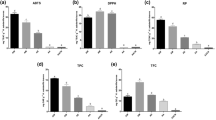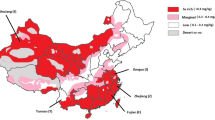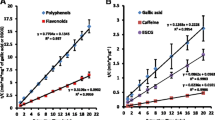Abstract
Tea is one of the most popular drinks next to water. Tea polyphenol is one of the main bioactive constituents of tea with health functions. In order to find the most bioactive tea polyphynols, polyphenol extracts from green tea, black tea and chemical oxidation products of green tea extracts were comparatively studied on the physicochemical and antioxidant properties. Results showed physicochemical and antioxidant properties of polyphenol extracts changed greatly after the chemical oxidation. Hydrogen peroxide induced oxidation products (HOP) possessed the highest antioxidant ability among the four tea polyphenol extracts. Thirteen phenolic compounds and one alkaloid in HOP were identified by reversed phase high-performance liquid chromatography coupled to diode array detection and electrospray ionization mass spectrometry (RP-HPLC-DAD-ESI-MS). Hydrogen peroxide induced oxidation of tea polyphenol extracts could improve the antioxidant activity and could be used to produce antioxidants for food industry.



Similar content being viewed by others
References
AOAC (1984) Official methods of analysis, 14th edn. Association of Official Analytical Chemists, Arlington, VA
Chen FK (1997) Measurement of the effective components of common Chinese Herb Medicine. People’s Medical Publishing House, Beijing, p 51
Del Rio D, Stewart AJ, Mullen W, Burns J, Lean MEJ, Brighenti F, Crozier A (2004) HPLC-MSn analysis of phenolic compounds and purine alkaloids in green and black tea. J Agric Food Chem 52:2807–2815
Ding L, Tu YY, Chen XM (2005) Progresses on the bioactivities of modified tea catechin. Tea Sci Technology 15:1–3
Duan XJ, Zhang WW, Li XM, Wang BG (2006) Evaluation of antioxidant property of extract and fractions obtained from a red alga, Polysiphonia urceolata. Food Chem 95:37–43
Guyot S, Vercauteren J, Cheynier V (1996) Structural determination of colourless and yellow dimers resulting from (+)-catechin coupling catalysed by grape polyphenoloxidase. Phytochem 42:1279–1288
Jhoo JW, Lo CY, Li S, Sang S, Ang CYW, Heinze TM, Ho CT (2005) Stability of black tea polyphenol, theaflavin, and identification of theanaphthoquinone as its major radical reaction product. J Agric Food Chem 53:6146–6150
Kaur R, Arora S, Singh B (2008) Antioxidant activity of the phenol rich fractions of leaves of Chukrasia tabularis A. Juss Bioresour Technol 99:7692–7698
Krishnan R, Maru GB (2006) Isolation and analyses of polymeric polyphenol fractions from black tea. Food Chem 94:331–340
Lee JH, Johnson JV, Talcott ST (2005) Identification of ellagic acid conjugates and other polyphenolics in muscadine grapes by HPLC-ESI-MS. J Agric Food Chem 53:6003–6010
Li CM, Xie BJ (2000) Evaluation of the antioxidant and pro-oxidant effects of tea catechin oxypolymers. J Agric Food Chem 483:6362–6366
Lin SD, Liu EH, Mau JL (2008) Effect of different brewing methods on antioxidant properties of steaming green tea. LWT Food Sci Technol 41:1616–1623
Oszmianski J, Cheynier V, Moutounet M (1996) Iron-Catalyzed oxidation of (+)-catechin in model systems. J Agric Food Chem 44:1712–1715
Sava VM, Galkin BN, Hong MY, Yang PC, Huang GS (2001) A novel melanin-like pigment derived from black tea leaves with immuno-stimulating activity. Food Res Int 34:337–343
Standley L, Winterton P, Marnewick JL, Gelderblom WCA, Joubert E, Britz TJ (2001) Influence of processing stages on antimutagenic and antioxidant potentials of rooibos tea. J Agric Food Chem 49:114–117
Suzuki M, Yoshino K, Maeda-Yamamoto M, Miyase T, Sano M (2000) Inhibitory Effects of Tea Catechins and O-Methylated Derivatives of (−)-Epigallocatechin-3-O-gallate on Mouse Type IV Allergy. J Agric Food Chem 48:5649–5653
Tanaka T, Matsuo Y, Kouno I (2005) A novel black tea pigment and two new oxidation products of epigallocatechin-3-O-gallate. J Agric Food Chem 53:7571–7578
Wan XC, Nursten HE, Ya C (1997) A new type of tea pigment from the chemical oxidation of epicatechin gallate and isolated from tea. J Sci Food Agric 74:401–408
Yen GC, Chen HY (1995) Antioxidant activity of various tea extracts in relation to their antimutagenicity. J Agric Food Chem 43:27–32
Yildirim A, Mavi A, Oktay M, Kara AA, Algur OF, Bilaloglu V (2000) Comparison of antioxidant and antimicrobial activities of Tilia (Tilia Argentea Desf Ex DC), Sage (Salvia Triloba L.), and Black Tea (Camellia Sinensis) Extracts. J Agric Food Chem 48:5030–5034
Yokozawa T, Nakagawa T, Kitani K (2002) Antioxidative activity of green tea polyphenol in cholesterol-fed rats. J Agric Food Chem 44:3549–3552
Zhou XL, Wang DF, Sun PN, Bucheli P, Li L, Hou YF, Wang JF (2007) Effects of Soluble Tea Polysaccharides on Hyperglycemia in Alloxan-Diabetic Mice. J Agric Food Chem 55:5523–5528
Zhu N, Huang TC, Yu Y, LaVoie EJ, Yang CS, Ho CT (2000) Identification of oxidation products of (−)-Epigallocatechin Gallate and (−)-Epigallocatechin with H2O2. J Agric Food Chem 48:979–981
Acknowledgements
This research is funded by the National Natural Science Foundation of China to H. Chen (Grant No. 30600470).
Author information
Authors and Affiliations
Corresponding author
Rights and permissions
About this article
Cite this article
Chen, H., Zhang, Y., Lu, X. et al. Comparative studies on the physicochemical and antioxidant properties of different tea extracts. J Food Sci Technol 49, 356–361 (2012). https://doi.org/10.1007/s13197-011-0291-6
Revised:
Accepted:
Published:
Issue Date:
DOI: https://doi.org/10.1007/s13197-011-0291-6




